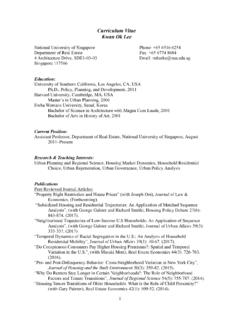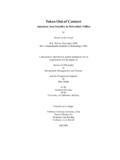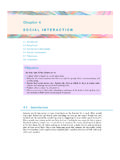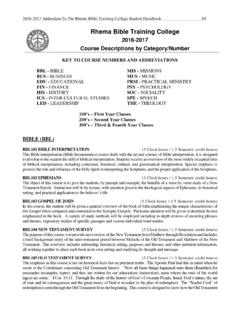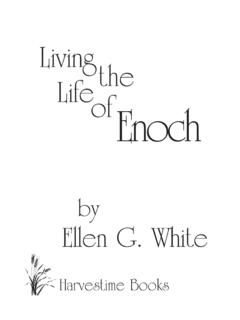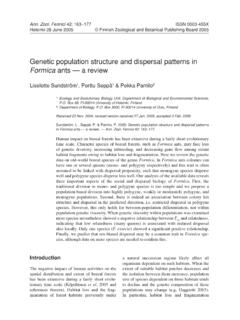Transcription of Ethnography The sensuous city: Sensory …
1 Ethnography2015, Vol. 16(3) 295 312!The Author(s) 2014 Reprints and : sensuous city: Sensory methodologies inurban ethnographicresearchKelvin LowNational University of SingaporeAbstractWhile urban dimensions of landscapes and the physical environment are often regardedas built structures that relate to functionality in modern life, cities are also sites ofhuman experience that comprise social relationships, memories, emotions, and howthey are negotiated on an everyday basis. Embedded within these processes of socialityis how the senses mediate one s engagement with urban life, hence rendering insightsinto the multi- Sensory character of urbanity. This article surveys a range of sensorymethodologies that may be harnessed towards articulating the social life of the senses inurbanity such as smellscape walkabouts in order to explicate the doing of sensoryethnography in urban contexts.
2 The aim is to elucidate how place, social actors, andsensory experiences come together in the production and analysis of urban ethno-graphic research, including the embodied constitutions of researchers in the processof data , urban Sensory experiences, Sensory methodologies, city, embodiment,SingaporeIntroductionCity life, comprising the everyday rhythms, humdrum of activities, events, rou-tines, and other un/expected urban encounters, comes with a range of multi- Sensory bombardment (Butler, 2006) emanating from both human and non-human sources. Motor vehicles, horns, voices, music, nature, and tactility arebut some of a wide range of possible examples that together form the sensuouscharacter of cities. In essence, there is a superabundance of Sensory affordancesthat are situated within the city. These varied Sensory experiences are not withoutCorresponding author:Kelvin Low, Department of Sociology, National University of : by guest on September 4, from social meaning or utility, as how spaces acquire meaning has to do with one s Sensory experiencing of built environments (Degen and Rose, 2012: 3271).
3 Whileurban dimensions of landscapes and the physical environment are often thoughtof in the fore as built structures that relate to functionality in modern life, citiesare also sites of human experience that comprise social relationships, memories,emotions, and how they are negotiated on an everyday basis. Embedded withinthese processes of sociality is how the senses mediate one s engagement withurban growth and development, hence rendering insights into the multi-sensorycharacter of of urban regeneration change the Sensory qualities of places(Degen, 2010). In turn, such changes also impact upon how particular culturalexpressions and practices are thereby included or excluded in city life. Whatroles do the senses play in urban built-up spaces across different societies andcultures? How are urban spaces of habitation built, designed or re-generatedsensorially?
4 In order to engage with these queries, this paper surveys a range ofsensory methodologies that may be harnessed towards articulating the social lifeof the senses in urbanity such as smellscape walkabouts in order to explicatethe doing of Sensory Ethnography in urban contexts. The aim is to elucidatehow place, social actors, and Sensory experiences in urbanity come together inthe production and analysis of urban ethnographic research, including theembodied constitutions of researchers in the process of data generation. Whatare the everyday Sensory realities of city life (DeFazio, 2011; Kalekin-Fishman,2010), and how are such experiences studied and analyzed? In other words,what are the necessary methodological approaches that aid towards theproduction and examination of Sensory ethnographies? Furthermore, how canlanguage be harnessed as a medium to both articulate and analyze the sensuouscity?
5 Theoretical engagements: Phenomenology, sensuous cities,and everyday lifeScholarly works that feature Sensory methodologies have appeared in recent documenting some of these methodological directions that have been under-taken in addition to my own suggestions, I wish to situate them alongside a rangeof theoretical trajectories (see also Low, 2012) which would then contextualizethese Sensory methodologies within ontological anteriors. In doing so, the discus-sion will demonstrate how the senses form an avenue of knowing (Pink, 2009;Vannini et al., 2012) that both organizes social life and contributes toward howsocial actors relate to urbanity through Sensory interpretations. Examining thesensuous city is therefore an endeavor in illustrating the social significance of sen-sations in space and social science scholarship on the senses has proliferated in the past fewdecades, one could already trace the genesis of how the senses are deliberatedthrough the works of sociological figures such as Durkheim, Marx, and 16(3) by guest on September 4, from Durkheim s philosophical lectures which he delivered in 1883 4 (see Gross andJones, 2004) reflect upon his development of sociology as a newly emerging disciplinethat was considered a philosophy project (Joas, 2004: xi xii).
6 In his discussions onthe philosophy of religion, aesthetics, and metaphysics, Durkheim s lectures also payattention to the senses. He is cognizant of the idea that the five-senses model is notabsolute. Instead of identifying senses using the usual five which many scholarshave critiqued (see, among others, Classen, 1993; Geurts, 2003; Vannini et al., 2012) Durkheim proposes both muscular sense and vital sense to refer to the state,position, and fatigue of our muscles and the general condition of our bodies interms of its well-being or malaise respectively, and which are regardless of specificlocation (Gross and Jones, 2004: 74). Similar to others such as Plato, Aristotle, andHegel who have ranked the senses (see Low, 2012), Durkheim embarks on hishierarchicization as follows (in reverse order): smell and taste (given that these are give us virtually nothing to appreciate ), the vital sense, sight andhearing (as aesthetic senses, which gives them their superiority ), touch (which canreplace sight and sometimes even hearing ), and the muscular sense (which togetherwith touch gives us knowledge of extension ) at the top of this list (Gross and Jones,2004: 74).
7 Calling this list a natural classification of the senses (p. 74), Durkheim streatment revolves around biological/perceptive qualities rather than situating themvis-a`-vis sociocultural comparison to Durkheim, Marx might have been slightly more explicit in hisdiscussion on the senses vis-a`-vis capitalist conditions and labor relations. In hisEconomic and Philosophic Manuscripts of 1844, Marx proclaims that the formingof the five senses is a labor of the entire history of the world down to the present (1959 [1844]: 109). As I have also discussed elsewhere (Low, 2012), the senses of theworker are negated as a result of operating within a sensorially injurious environ-ment that is accompanied by such transgressions of noise and temperature, amongother Sensory challenges (Marx, 1954). Apart from contextualizing the senses andsensuousness as both socially and historically contingent (DeFazio, 2011), Marxhas also ranked the senses in a manner which departs from Durkheim s.
8 Smell,taste, and touch are assigned lower statuses given the link to animality, whilehearing and sight are accorded higher positions in the hierarchy as a result ofthe connection to civility (see Howes, 2003). In essence, both Durkheim s andMarx s hierarchy of the senses may be perceived as an initial glimpse into thesociocultural workings of the senses and how they are contextualized within cog-nate debates drawn from philosophy, science, and economics. Another importanttheoretical framework in discussing sensation is phenomenology, which I (2004: 12) suggests that how the senses organize our experience, andhow they constitute the physical world, are not noticeable unless we adopt a detached manner to analyze ordinary experience, in following Merleau-Ponty sarguments on perception and lived experiences. Such detachment, according toMerleau-Ponty (2004: 39), has to be executed on the basis of rediscovering the world in which we live, yet which we are always prone to forget.
9 For him, theLow297 by guest on September 4, from quality of an object is necessarily contingent on a dialogic relationship between theindividual as an embodied subject and the external object which bears this quality (Merleau-Ponty, 2004: 61). Using the stickiness of honey and one s tactile encoun-ter with it as an example to illustrate this relationship, Merleau-Ponty notes thatthings are not merely objects which are neutral. Instead, the ways in which peoplerelate to the world have to do with how objects provoke certain reactions that maybe favorable or otherwise. In other words, Merleau-Ponty draws attention to sen-sation, which for him occupies the center of human perception (Pink, 2009).Furthermore, including the body of the researcher and of the researched as partof the process of ethnographic inquiry and data collection would thereby facilitate greater phenomenological sensibility to Ethnography (Kusenbach, 2003: 455; seealso, Gandhi and Hoek, 2012; Mears, 2013; Wacquant, 2004).
10 Theorizing thesenses in social life through urban ethnographic research therefore requires reflex-ive attention on how corporeal practices are central to the generation of ethnog-raphy. Such reflexivity is in line with the writing culture debate in anthropologythat emphasizes cognizance of how ethnographic knowledge is constructed, includ-ing the importance that is placed upon embodiment in social experiences (see,among others, Geertz, 1988; Howes, 2003; Marcus, 1998; Stoller, 1997).City life and the senses: Simmel and othersIt is by now evident that the senses have been debated within a range of disciplinesand on the basis of various theoretical positions. Moreover, the hegemony of visionseems to cloak the importance of the other senses in appraisals of city life and in theemployment of ethnographic fieldwork in general (Atkinson et al., 2008; Bendix,2011; DeFazio, 2011; Sparkes, 2009).
